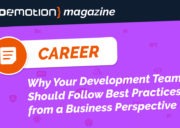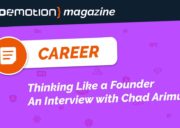
Remain focused on your career path
If you want to be prepared to make the right decisions at the right moment on your career path, it’s essential that you understand your wants and needs as well as all the options in front of you. Subscribe to our newsletter to keep reading our developer career-focused content as it is published!
The Chief Technology Officer is a key role – the driver of all internal processes inside a company. A strong CTO wants to bring about change in his or her company, creating sustainable success in the marketplace. Their dominant characteristic is ‘a willingness to challenge the status quo‘.
An unstructured shortlist of CTO qualities includes mastery of systems engineering, a clear map of the company’s current technology, mastery of new technologies and all their related implications, the ability to correctly model the customer base, and connections with other stakeholders (research centres, start-ups, funding institutions).
A long list, there is no single ‘right’ way to incorporate these qualities into a CTO’s activity. The landscape offered by different companies includes numerous variants. Matching your qualities with what companies need leads to a taxonomy of different kinds of a CTO.
First, a general look at the role of a Chief Technical Officer working in the ICT industry, then a more general perspective from the broader tech industry, before we finally evaluate the two roles within a 4×4 matrix.
The ICT-tech CTO
The ICT industry has long offered many and varied categorizations of the role of the CTO. A four-type framework of categorization has been particularly successful. This framework is still used in many scenarios, often with only limited editing, so it may be worth taking a look at it.
The four categories of CTO in the ICT field are the Visionary, the Infrastructure Commander, the Customer Champion, and the Big Thinker. We will refer to the synthetic infographic introduced by Access Alto, but similar analyses have been completed by other experts and consulting firms.
Access Alto also offers an intriguing chart that better describes its categorization of CTO characteristics.
The Infrastructure Commander
Works on the front line to put in place the technological vision of others. The technical strategy to be implemented has been pre-approved, so this CTO oversees infrastructure, network, security, and maintenance.
The Big Thinker
Creates the business model of the company, doing the strategic jobs necessary to compare a company with its competitors. The Big Thinker has strong relationships with all their C-level peers in the upper reaches of the organizational chart but simultaneously works with those on lower levels, verifying that technologies have been fully implemented within the organization according to the agreed strategy.
The Visionary
Usually associated with the organization from its inception, the Visionary is responsible for devising technical strategies and blueprints of the business model. For CTOs in this category, the agenda is to drive the business forward.
The Customer Champion
This CTO has a deep understanding of the company’s customers. Responsible for delivering customer excellence in UI and UX, the Customer Champion is the face of business and focuses on problem solving.
The general-tech Chief Technology Officer
New technologies open new doors to well-educated CTOs, especially to those who come from a field in which competition is tough, such as the ICT arena. It’s consequently a good idea to take a look at how the chief technology officer behaves within the bigger picture.
Looking at the broader landscape, the general-tech CTO role has always been categorized too. Another four-type categorization is interesting in terms of the scope of this article. A notable analysis by McKinsey describes four different types of general-tech CTOs: the Challenger, the Influencer, the Owner, and the Enabler.
The end result is two lists of four types each, covering a broad base of CTOs in tech. We can put these types into a 4×4 matrix that describes the fundamental characteristics of the CTO job relative to both ICT-related technologies and the non-ICT-related technologies used inside the company.
From that starting point, every CTO has to find their own unique way to do the job, bearing in mind many factors such as education, agility, and value metrics.

The Challenger
The Challenger uses creative tension and veto power to improve R&D performance by injecting additional scrutiny, external perspectives, and rigour into activities and processes owned by the business units.
The job description focuses on external interfaces and strategy and portfolio management.
The Influencer
The Influencer CTO has low direct control over both R&D and technology, but acts as a sounding board, counseling business leaders on their R&D programs and campaigning throughout the business to garner resources for top-priority ideas.
The job description focuses on internal and external interaction, with particular attention paid to the external side (e.g., partnerships).
The Owner
The Owner is the person in charge of a single product or service. Centralizing all R&D personnel and budgets underneath him or her, the Owner consequently has complete control of product and technology development in the company. The job description focuses on strategy and portfolio management and processing personnel management. The Owner is completely dedicated to interactions within the company.
The Enabler
The Enabler chief technical officer is similar to the Influencer in their low degree of control over R&D and technology inside the company. This tye of CTO focuses on making the R&D function faster and more effective by improving processes, cross-pollinating ideas, and improving skills levels, or by increasing investment in a few company-critical projects.
The job description focuses on capability building, internal interactions, and process and personnel management. The Enabler is the most managerial type of CTO.
The number of R&D projects that need to be managed is a factor in driving the CTO’s focus inward or out of the company. Owners and challengers with many R&D projects to manage tend to be internally focused. Enablers and influencers, managing a low number of projects, are more likely to focus on what is happening outside the company.
Chief Technology Officers: a 4×4 matrix
There is no direct correlation between the two four-type sets of CTO categories. Although it is easy to find common attributes among all eight descriptions, the only way to come up with an overall methodology is to start with a three-dimensional 2x2x4 array, or with a simpler 4×4 array.
Simplifications can occur later, refining a bespoke model to become the most effective CTO possible, regardless of the underlying technology and the specific industry, but nonetheless considering all stakeholders, from teams and employees to customers and suppliers.

CTO role: Pros and Cons
A C-level executive is not always given sufficient time to understand a situation. While this is often the case in early-stage start-ups, the CTO is also like the new manager of a football team in normal companies, needing to win matches from the very beginning of the new season.
The less sophisticated the technology, the lower the R&D expenses, and the lower the control the CTO needs to exert over technology agendas and priorities. The two models in the lower part of the diagram, i.e., ‘influencers’ or ‘enablers’, seem the best suited in these cases.
Influencers (often found in consumer-goods companies, for example) are often scouts – deep thinkers who advocate for innovation through partnerships with providers of new technologies.
Enablers are more managerial, tasked with driving efficiencies in multi-business-unit organizations with a high degree of overlap among technologies and projects between business units.
On the other side, the higher the costs (in pursuit of better technology), the higher the degree of control the CTO ought to apply to the elements involved. This is where Challengers and Owners normally thrive.
A Challenger’s company normally has multiple business units, each with its own R&D department, necessitating deep cooperation.
An Owner’s paradigm can be implemented in start-ups or small enterprises, where it is most common to market only one product or service. Owners and enablers are generally more internally-focused, while challengers and influencers have more capacity to focus on the external environment and interfaces.
The McKinsey report offers intriguing insights into what drives different CTO types. “The styles of influencer and owner are typically the most challenging to execute”, due to specific biases. Control over resources is held by R&D, “so that only someone both technologically and interpersonally astute is usually able to make this style work”.
The knot Owners have to loosen is tied to market realities, easily hidden if this kind of CTO directly controls R&D resources.
“When implemented correctly, the enabler and challenger styles offer a more balanced approach that is particularly effective in companies where R&D is more decentralized. The key is to grant the CTO the right amount of hard power”.
Enablers can determine the speed of adoption of processes and projects. They “get positive power: typically, a combination of expert personnel and financial resources he or she can use to accelerate important projects”.
On the contrary, Challengers get the negative power given from the ability to terminate, deemphasize, or delay projects that are inconsistent with the company’s strategy, are not on track to achieve the target product profile, or are suffering from significant delays or cost overruns”.
The visionary-enabler Chief Technology Officer and other starting points
Now we have a 4×4 matrix of sixteen general CTO personas. We can consider all of them, splitting the ICT component from the general-tech component. All of these categories can offer hints on how to approach this difficult role, before leaving all subsequent steps to the manager. The pairs generated by the matrix can be intriguing.
The Challenger-Commander, to single out one style, oversees all aspects related to the ICT infrastructure, has a high degree of control on R&D and technology, and pushes performance ahead through a strategy based on tension.
The Visionary-Enabler is one of the most exciting and adrenaline-junkie CTOs. In control of every single tech step since the beginning, this types fosters skill levels, processes, and investments, to the exclusive advantage of the business.
Education, agility, and value metrics
We can now choose our starting point from a set of sixteen different possibilities. The correct managerial style as a CTO is not a picture, but a moving target that has to follow the evolution of the company and its business goals inside a fast-changing world. Let’s look at some of the most likely sources of change for a CTO’s managerial rules.
Company dimensions, technology infrastructure, R&D budget, R&D mapping inside the company, and the category and number of products and services are just a few of the variables that should be considered when shaping the real duties and powers of a valuable CTO.
The role of consulting companies consists first and foremost of analysing an industry, secondly, of building complete frameworks to encompass all actors of an industry, and thirdly in going into the details of every kind of actor.
The consulting company McKinsey again presented the results of a survey about technology transformations in February 2020. The final conclusion of the survey asks for different analyses and strategies to be implemented in three key areas: education, agility, and value metrics.

The right education
Well-educated professional figures, fully integrated with modern requirements, are just as necessary to a business as the adoption of modern technology. Nobody need any longer be ashamed of being technologically prepared while lacking a great literary or historical competence.
The term ‘culture’ is often misused and technology is simply sidelined when it comes to traditional knowledge: we cannot think without tradition – in reality, tradition is objectively secondary in the vast majority of situations today.
Thorough training, updated management, and immediate verifiability of qualifications are the points on which excellence is established.
Updated management
Mapping IT to business is still a job far removed from being agile and resilient to constant change. The ongoing digital transformation has improved the quality of the software being developed, of course, but it also offers the opportunity to establish better processes to produce corporate value.
Integrating partners into business processes also brings continuous collaboration – the ultimate goal of any partnership – closer.
Immediate verifiability
The problem of metrics is perhaps still the central issue. A company that manages to quantify the value created with or by technology has a great deal more chance of being successful on the market. It is the task of the executive who deals with strategy, i.e., the CTO or CIO, to go from evaluating costs and risks (a process dear to CFOs) to measuring created value.
The evaluation cycle must be agile, shortening the time required but also involving more areas of the company.
Remain focused on your career path
If you want to be prepared to make the right decisions at the right time for your career, it’s essential that you understand your wants and needs as well as all the options in front of you. Subscribe to our newsletter to keep reading our developer career-focused content as it ispublished!




